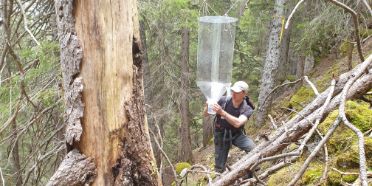Protection forests and biodiversity conservation: synergies and trade-offs
The BERNICE project identifies synergies and trade-offs between biodiversity conservation and protection against natural hazards in Swiss forests and assesses their potential for the conservation of biodiversity.
Steckbrief
- Beteiligte Departemente Hochschule für Agrar-, Forst- und Lebensmittelwissenschaften
- Institut(e) Multifunktionale Waldwirtschaft
- Forschungseinheit(en) Waldökosystem und Waldmanagement
- Förderorganisation SNF
- Laufzeit (geplant) 01.10.2025 - 31.12.2029
- Projektleitung Prof. Dr. Thibault Lachat
-
Projektmitarbeitende
Prof. Dr. Thibault Lachat
Prof. Dr. Luuk Dorren
Dr. Christine Moos
Prof. Dr. Massimiliano Schwarz -
Partner
Schweizerische Vogelwarte
Bundesamt für Umwelt BAFU
WSL-Institut für Schnee- und Lawinenforschung SLF
SBB AG - Schlüsselwörter Saproxylic species, Heliophilous species, Old-growth forests, Natural hazards, Biodiversity conservation, Forest management, Simulation models
Ausgangslage
Protection forests account for 49% of Swiss forests, reaching over 80% of forests in mountainous regions. These forests are managed according to the so-called NaiS guidelines, which define the requirements for the sustainable provision of the protective service against natural hazards. However, managing protection forests can sometimes conflict with biodiversity conservation, as it tends to minimize early and late forest development stages, which are recognizes as biodiversity hotspots in temperate forest ecosystems. This project wants to investigate to which extent "old-growth" forest structures, such as larger quantities of dead wood or older habitat trees, can be integrated in protection forests without substantially impairing their protective effect. To achieve this, the relationships, potential-trade-offs, and synergies between protective effects, forest structures and biodiversity across different successional stages and management regimes will be assessed and quantified.
Vorgehen
To identify synergies and trade-offs between biodiversity conservation and forest protection measures in Swiss forests, 90 study sites in protection forests representing three natural hazard processes (avalanches, rockfall, and shallow landslide) will be selected and assessed. On each study site an inventory of the species including insects, birds, bats and mycorrhizal fungi will be carried out. Furthermore, an inventory of forest structures including DBH measurements, identifying tree species and their tree-related microhabitats, and a detailed inventory of lying and standing dead trees. Furthermore, there will be a quantification of the protective effects against the corresponding natural hazard on each site. All this data is then used to identify drivers on biodiversity and relationships with protective effects.
Ausblick
The BERNICE project will deliver new insights into how biodiversity conservation and natural hazard protection can be jointly optimized in Swiss forests. By collecting high-resolution data on species and forest structures across 90 protection forest sites and applying advanced modelling tools, the output consists of robust evidence for multifunctional forest management. This will feed into updated indicators and recommendations for forest managers (NaiS), enabling the integration of biodiversity-enhancing practices—such as promoting deadwood, habitat trees, and old-growth structures. The outcome will be the revision of FOEN’s Program Agreements and influence national forest policy, ensuring protective functions are maintained while biodiversity is promoted. The long-term impact will be healthier forest ecosystems, improved habitat conditions for threatened species, and increased resilience to climate-related disturbances. In parallel, BERNICE will engage stakeholders such as SBB and cantonal forest authorities through factsheets, workshops, and collaborative site selection. These partners will begin implementing biodiversity-friendly practices, guided by project findings and supported by training and decision-making tools (outcome). This uptake will foster a cultural shift in forest management. By aligning ecological goals with protective functions, BERNICE supports Switzerland’s biodiversity commitments and the 30x30 targets.

